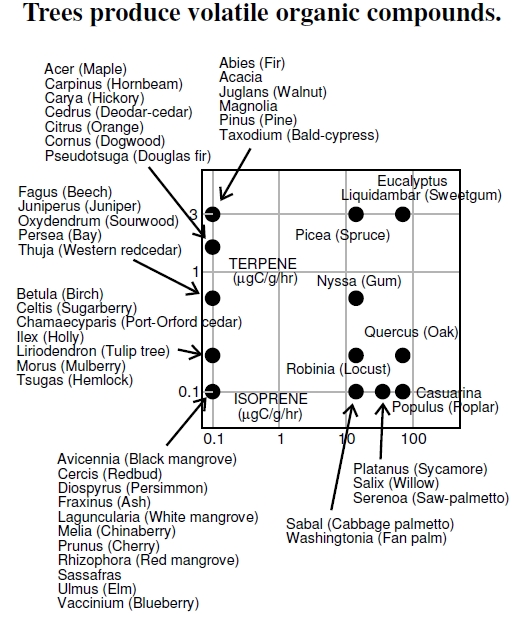4. 3 Tree Pollution
 Figure 4.3: Trees release thousands of chemicals that play roles in protection from thermal stress and herbivory, attractants for pollinators, and plant–plant antagonisms. Here I plot emissions of two such biogenic volatile organic compounds, monoterpenes and isoprene, for various species (data by Guenther et al. 1994). Low-emission trees include the beautiful redbuds and super fast-growing tulip-tree, whereas the fast-growing sweetgum has high emissions. Southeastern forests support many of the native and introduced species listed here.
Figure 4.3: Trees release thousands of chemicals that play roles in protection from thermal stress and herbivory, attractants for pollinators, and plant–plant antagonisms. Here I plot emissions of two such biogenic volatile organic compounds, monoterpenes and isoprene, for various species (data by Guenther et al. 1994). Low-emission trees include the beautiful redbuds and super fast-growing tulip-tree, whereas the fast-growing sweetgum has high emissions. Southeastern forests support many of the native and introduced species listed here.
Natural biological processes, as well as fossil-fuel emissions, affect the chemical reactions that take place in the air we breathe. Vegetation contributes to the chemical composition of our air, and Figure 4.3 summarizes the biogenic VOC contributions from many important southeastern tree species. Even though many people fear the words “chemical” and “nuclear,” solar power equals thermonuclear fusion, and an organism equals a container of chemicals. Fortunately, that massive, uncontained fusion reactor sits 150 million km away. Context is what matters.
Not to overstate Mother Nature’s toxic side, but the process of natural selection produced many toxic chemicals, poision ivy and bee stings being just two personal examples. These chemicals arose as a result of natural selection, sometimes because of their role in the chemical dance taking place between plants and their herbivores, pollinator attraction, and competitive interactions with other plants. For every bit of sweet nectar that seduces insect pollinators there exists a chemical defense turning caterpillars into gooey masses. Natural selection takes place when a tree that makes a bit more of a nasty chemical deterrent to herbivores, or attractive chemical lure to mutualists, produces a few more seeds than its competing trees. Repeating this process of births and deaths over hundreds or thousands of generations, with inevitable recombination and mutations, results in evolutionary change and a diversity of chemical defenses. Hence, the biogenic VOCs over southeastern forests.
Tens of thousands of these chemicals can be called biogenic VOCs, with broader classes defined according to chemical structure.[15] I plot just two VOCs for a variety of species.[16] Terpenes,[17] a broad class of compounds of one or more isoprene molecules, may play a role in plant defense against herbivores and fungal infection, and isoprene plays a role, perhaps, in thermal protection.[18] Keep in mind that these estimates have very high levels of uncertainties,[19] and all of the emissions are normalized to 30C and average sunlight.[20]
Notice how the conifers are located high on the terpene axis and how some trees have high emissions on both axes. The tulip tree, one of my favorite fast-growing trees in the southeastern United States, has rather low emissions. Just like VOCs from burning fossil fuels, these natural VOCs sometimes play a role in ozone formation, though pretty much in any context I’d rather breathe forest air than the emissions from tailpipes.[21]
——————————-
[15]Lerdau et al. (1997) have a detailed discussion of chemical defenses in trees.
[16]Guenther et al. (1994) discuss emission levels for different tree species. Measurements were taken at the branch level, meaning that they accounted for self-shading and such.
[17]When you think of terpenes, think of terpentine, made from the pine tree resin, and menthol as just two examples.
[18]It’s neat that natural selection ended up making one molecule, isoprene, useful for one thing (heat protection), and it just so happened that a couple of the molecules stuck together helped protect against herbivory. Evolution just happens, using whatever junk an organism already has built-in. Also, I certainly can’t feel ill-will toward trees, what with my use of sunscreens, mosquito and tick repellents, and itch relief compounds, though the natural world might be to blame in the first place. Also note that some VOCs play no functional role in herbivory or stress reduction; these chemicals of life can just leak out from stoma and herbivore wounds.
[19]Geron et al. (2001) argue that numbers like those shown for isoprene and terpene emissions are, in some cases, an order of magnitude too low. Guenther et al. (1994) state that isoprenes and terpenes can account for less than 20% of emissions for some plant species, but can also account for up to 80% for some forests.
[20]Half of full sunlight, which I called average, is considered a photosynthetically active radiation flux of 1000 μmol/m2/s, which is nearly equivalent to the heat energy of a 100-Watt bulb every square foot.
[21]President Ronald Reagan’s famous 1981 quote that “trees cause more pollution than automobiles do” had a kernel of truth to it, though he ought to have said simply that trees emit volatile organic compounds and left it at that. The “more than automobiles” bit dismisses too much nuance.